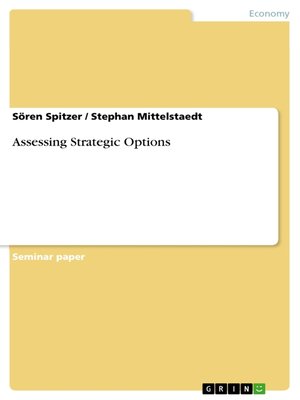
Sign up to save your library
With an OverDrive account, you can save your favorite libraries for at-a-glance information about availability. Find out more about OverDrive accounts.
Find this title in Libby, the library reading app by OverDrive.



Search for a digital library with this title
Title found at these libraries:
| Library Name | Distance |
|---|---|
| Loading... |
Seminar paper from the year 2005 in the subject Business economics - Miscellaneous, grade: 1.3, Heilbronn University of Applied Sciences, 24 entries in the bibliography, language: English, abstract: The company was founded in 1909 and is up to now a fully state-owned business, which is public limited since 1992. It is active both in B2B and B2C market. After the Transit Directive of the European Commission in 1990, which enabled open trade in electricity markets and the fall of the Berlin Wall, Vattenfall extended business activities to Finland, Germany, and Poland. Acquisitions of Finnish network companies build the basis of today's Vattenfall Oy (mid 1990's) which is, amongst the Swedish location, part of Vattenfall Nordic. At the polish market Vattenfall acquired EW, Warsaw's electricity and district heating company as well as GZE, the largest national electricity supplier. The polish businesses are represented by Vattenfall Poland. As a result of the liberalization of the German power market in 1998, RWE and Eon, the market leading companies, have been forced to sell some valuable assets of the eastern part of Germany preventing dominance of the market. Due to this chance, Vattenfall bought BEWAG, HEW Hamburg, VEAG and the lignite mining company Laubag, which later merged into Vattenfall Europe, today Vattenfall´s largest business sector with a portion of 60% of sales. Figure 1 of the appendix demonstrates the current structure of Vattenfall Europe in 2004. Today over 33,000 employees are working for Vattenfall. In 2004 they generated approximately 167,000 GWh (Giga-Watt-hour), which equals 5.5% of overall european power generation and had net sales of 12.6 billion €, which made Vattenfall to Europe's fifth largest generator of electricity. Vattenfall's overall goal of today is to become one of the leading european energy companies. (www.Vattenfall.com; 2005) The future preparations of Vattenfall are reflected by its R&D efforts in renewable energies as well as in the extension of transmission networks especially in the German electricity market, which is the biggest in Europe. Due to the 100% state-ownership, it is easier for Vattenfall to get necessary investment funds. According latest news Vattenfall Europe is going to spend 300 Mio. Euro for the construction of 360 kilometres of overland supply networks in Germany, in order to transmit energy throughout Germany, generated by wind power stations at the Baltic Sea. This will make Vattenfall to the second largest power supplier of wind energy in Germany behind Eon. Additionally Vattenfall is going to built two more coal fired power stations in Hamburg and Saxony. (Handelsblatt 2005-05-04)







